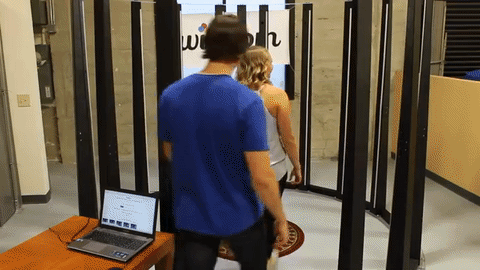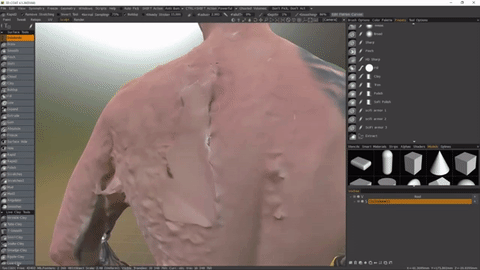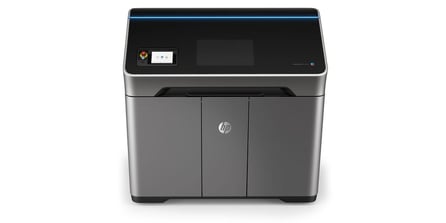The 3D figurine market has grown rapidly over the last year and is expected to continue as full body 3D scanners become more portable, 3D printed figurines become cheaper and end consumers become more familiar with the technology. There has never been a better time to start a 3D figurine business with the 3D technology finally starting to catch on. In this post we are going to go over the 3 major parts of every 3D printed figurine business (Note: people in industry will use 3D printed figurine, 3D portrait, and 3D selfie interchangeably). The 3 parts are the:
- Full body 3D scanner
- 3D digital retouching
- Full color 3D printer
*Note: Scroll to the end of the article for an update on the latest technologies and strategies people are using for 3D printed figurine businesses.
Full Body 3D Scanner

The full body 3D scanner is what captures the photo data of your customer before it is turned into a 3D model. There are many types of 3D scanners on the market, but not all of them are well suited for 3D portrait businesses. When you're looking for suitable full body 3D scanners for your 3D portrait business you want to target ones that are: instaneous, consistent and portable. Hybrid full body 3D scanners (combination of photogrammetry and structured light) are usually the best options. DSLR photogrammetry systems usually require too much calibration to get consistent results and handheld 3D scanners require too much time spent digitally post processing the files.
3D Digital Retouching
 Once a 3D scan is taken on a full body 3D scanner the data needs to be sent to a 3D artist to be retouched. Unlike taking a picture on a regular digital camera and printing it out a 2D photo printer, all 3D scans require manual 3D digital modeling work before they can printed on a full color 3D printer. 3D scanning is still an imperfect technology and isn't capable of capturing the contours all 3D surfaces with 100% accuracy. For example, shiny objects are very difficult to 3D scan since they look different from different perspectives. To fix problems created from the 3D scanning process, 3D artists will use programs like Zbrush, Autodesk Maya, and 3DS Max to correct geometry and fill in missing texture. The amount of digital retouching needed for a 3D scan can vary widely, but you should expect to spend a minimum of 30 minutes and in some cases up to 8 hours depening on the quality of the scan data and the level of accuarcy needed for the final 3D print. If your using Twindom for fulfillment this is automatically done for you on every single 3D print your customers order.
Once a 3D scan is taken on a full body 3D scanner the data needs to be sent to a 3D artist to be retouched. Unlike taking a picture on a regular digital camera and printing it out a 2D photo printer, all 3D scans require manual 3D digital modeling work before they can printed on a full color 3D printer. 3D scanning is still an imperfect technology and isn't capable of capturing the contours all 3D surfaces with 100% accuracy. For example, shiny objects are very difficult to 3D scan since they look different from different perspectives. To fix problems created from the 3D scanning process, 3D artists will use programs like Zbrush, Autodesk Maya, and 3DS Max to correct geometry and fill in missing texture. The amount of digital retouching needed for a 3D scan can vary widely, but you should expect to spend a minimum of 30 minutes and in some cases up to 8 hours depening on the quality of the scan data and the level of accuarcy needed for the final 3D print. If your using Twindom for fulfillment this is automatically done for you on every single 3D print your customers order.
Full Color 3D Printer
 Once the 3D model has been fixed by a 3D artist it is ready to be 3D printed on a full color 3D printer. While there are multiple full color 3D printers on the market, there are only a couple 3D printers available that are suitable for printing 3D printed figurines: The Jet Fusion 580 by Hewlett Packard and the 3DUJ-553 by Mimaki. You can read more about the HP 580 and Mimaki 553 here. Due to the time and capital investments involved in becoming proficient with the above mentioned 3D printers, most 3D printed figurine companies outsource this part of the business and have the prints shipped back to them in bulk or white label shipped to the end customer. For all Twinstant customers we offer direct shipping of 3D printed figurines to customers at prices that are up to 75% cheaper than other 3D printing companies.
Once the 3D model has been fixed by a 3D artist it is ready to be 3D printed on a full color 3D printer. While there are multiple full color 3D printers on the market, there are only a couple 3D printers available that are suitable for printing 3D printed figurines: The Jet Fusion 580 by Hewlett Packard and the 3DUJ-553 by Mimaki. You can read more about the HP 580 and Mimaki 553 here. Due to the time and capital investments involved in becoming proficient with the above mentioned 3D printers, most 3D printed figurine companies outsource this part of the business and have the prints shipped back to them in bulk or white label shipped to the end customer. For all Twinstant customers we offer direct shipping of 3D printed figurines to customers at prices that are up to 75% cheaper than other 3D printing companies.
Conclusion
As you can see there are a lot of moving parts to operating a 3D printed figurine business. At Twindom we try to make starting and operating a 3D printed figurine business as easy as possible for our customers. With the Twinstant Mobile full body 3D scanner and Twindom Cloud Platform, our goal is to make it so customers spend none of there time digitally processing 3D models or worrying about how they are going to 3D print customer orders. Instead they get to spend more time figuring out how they are going to grow their business.
Update since original posting
Full Body 3D Scanners- When this article was originally published the market was going through a transition from structured light and DSLR photogrammetry 3D scanners to hybrid full body 3D scanners. For the most part, that transition is now complete and most new full body 3D scanners being sold for 3D printed figurines are hybrid full body 3D scanners. Many of the people that originally purchased the 1st generation of hybrid full body 3D scanners are now also using them for AR, VR and medical applications.

3D Digital Retouching- While workflows for the 3D digital retouching have gotten a tiny bit faster they are still a massive pain for 3D printed figurine businesses. Most companies have discovered that it is more profitable for them to outsource this part than do it themselves. To differentiating themselves some 3D portrait companies are offering more premium HD 3D printed figurines where features like hair and creases in clothing are more accentuated in the final 3D print. This new service is often called HD or Premium Retouching.
Full Color 3D Printer- For many years, the Projet 660 was the dominant full color 3D printer on the market for making 3D printed figurines. In recent years, full color 3D printers have come on the market that are able to match the color accuracy and material cost of the Project 660 full color 3D printer. The next wave of full color 3D printers are unseating the Projet 660 with their full color plastic 3D portraits. The new generation of full color 3D printers produce higher color quality, better resolution and also produce 3D printed figurines that are much more durable than the full color sandstone ones produced by the Projet 660.
Want to learn more insights?


